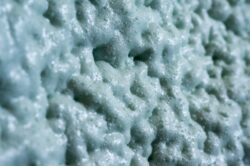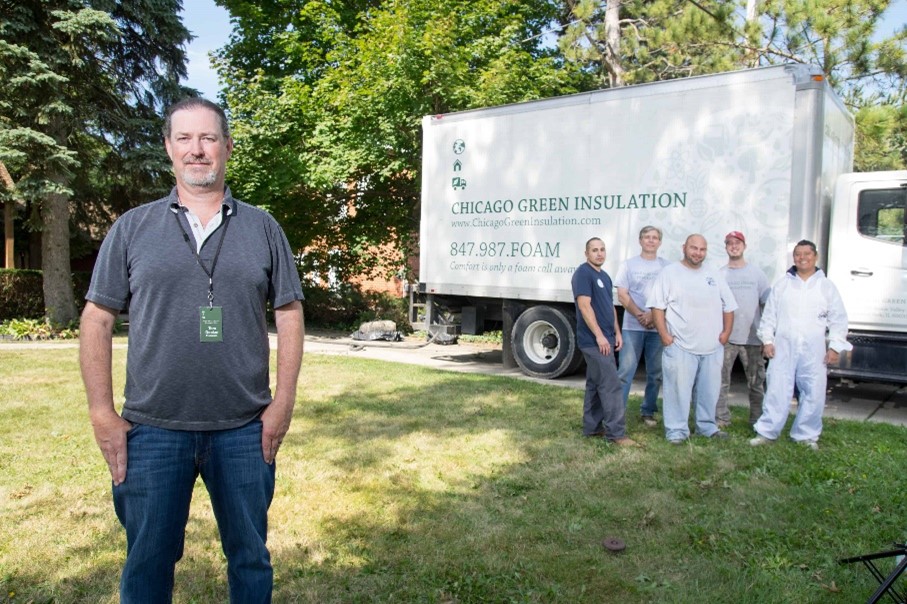Chicago-area businessman Tom Decker is on a mission. He wants to transform the area’s homes and buildings into energy efficient, stronger structures that are more environmentally friendly and disaster resistant. His piece of the climate puzzle is the insulation inside the walls.
When he launched Chicago Green Insulation in 2013, offering spray foam with a renewable soy component as a more energy efficient insulation option became his passion. He views the environmental, economic and social benefits as a perfect nexus for a superior product. Decker offers the soy-biobased Heatlok® closed-cell insulation made by Huntsman Building Solutions, a spray foam insulation that incorporates renewable soybean oil to reduce petroleum content. He believes the environmental, economic and social benefits combine for superior insulation.
“It’s better for our resources to come from above ground than from below ground,” said Decker, regarding why he sprays foam insulation that uses soybean oil as an ingredient to reduce the petroleum content.
Business is Booming

Decker installs Heatlok made with U.S. Soy, a spray foam insulation that hardens inside the walls once applied.
Demand is high for the product, thanks in part to tighter state regulations and a surge of renovations from people wanting to stay in their homes.
Illinois adopted the 2021 International Energy Conservation Code, which has much higher standard for “resistance to heat flow” and air leakage.
“Spray foam insulation is pretty much the only way to meet these new higher standards,” he said. “People are having to learn a new way of building.”
In a way, the rest of the construction industry is having to catch up to Chicago Green Insulation, Decker says. Although the soy product is just one option, it makes up most of that portion of Chicago Green Insulation’s business, he said.
“More discerning buyers want every value-add that they can make to the universe with their choices,” he said.

Heatlok with U.S. Soy is a closed-cell spray foam insulation that also incorporates recycled plastic bottles. According to Huntsman, it has a high R-value of 7.4 at 1 inch, and a density of two pounds. The renewable soybean oil content in the polyol used to make Heatlok is 13.5 percent.
A Thanksgiving to Remember
In 2020, the Kay family spent a memorable Thanksgiving at their home in Barrington, Illinois. About 20 guests gathered at the 60-year-old house. After the meal, but before dessert, the owners fired up the rarely used fireplace for the occasion. Some unseen erosion led the fire to escape the chimney, and everyone had to evacuate as the home burned.
The family turned to Decker for help. The 1950s-era 2-by-4 walls were taken down to the studs and rebuilt with 3 inches of soy foam.
“By Thanksgiving in 2023, the house was dramatically more comfortable – far less drafty and just cozier in general,” said Buddy Kay. “We’ve been very happy with the spray foam insulation – upgrading to that was something good that came out of what was a disaster at the time.”
Investment, Insurance and Incentives
Decker notes the soy product can be more expensive than traditional spray foam.
“I call it ‘top-shelf’ spray foam – a class above the others,” Decker says. “It’s an investment in your home that is well worth making.”
In the case of the Kay family, insurance covered the extra cost for the spray foam insulation because the policy had “code-upgrade,” meaning when building codes change, the owner is covered for any increased expense as a result. There are new federal credits available to customers through the Inflation Reduction Act of 2022. There are other smaller credits out there that help low-income homeowners too. Decker helps his customers take advantage of the incentives.
The Benefits
Spray foam insulation, when properly installed, offers significant benefits, including the following:
- Maximizes energy efficiency, resulting in reduced heating and cooling costs
- Provides a stronger air barrier than traditional insulation
- Provides a vapor barrier and a moisture barrier
- Seals cracks, gaps, and voids
- Meets the 2021 International Energy Efficiency building code
- Reduces dust and pollen
The closed-cell Heatlok product makes buildings stronger because it becomes part of the structure itself, holding everything in place and keeping out the wind. Since it bonds tightly to surfaces in the attic, ceiling and walls, outdoor noise is also minimized.

Jose Ramirez, a worker with Chicago Green Insulation, sprays foam insulation onto the walls of a home. It hardened and became part of the home’s structure.
Coming Full-Circle with Soy
Decker says he gets calls every week where the first question is, “Do you use spray foam containing soy?” Living in one of the top soybean-producing states in the nation, he’s proud to answer he does.
“I clearly understand what it means to farmers to have their soybean oil in this product,” Decker said. “My market may be homeowners in Chicago, but I understand the full-circle impact on the state of Illinois. We can support farmers, they can grow crops profitably while providing a product that is sustainable and green. Everyone benefits.”
Decker, the father of two children, views lowering heating bills as a worthwhile issue. “This product is not just for high-end neighborhoods,” he said. “In fact, I get really passionate about installing this in middle and lower-income areas, because they’re the ones who benefit the most from lower heating bills.”

